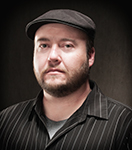
William Grassie
Las Vegas, N.M. –New Mexico Highlands University media arts graduate William Grassie was featured in MAKE magazine for his cutting-edge thesis project that created a three-dimensional photographic model that will help guide the restoration of the historic trolley building in Las Vegas.
Grassie’s article, “Quadcopter Photogrammetry,” details how he developed his novel idea of mounting a camera on a small radio-controlled quadcopter to generate a 3-D model for architectural conservation and preservation.
“I set out to build a quadcopter as a stabilized camera platform to create photogrammetric 3-D models of large-scale historic buildings,” Grassie said. “Photogrammetry is a computational photography method for creating 3-D models of objects by taking a series — often hundreds — of still photos that overlap.
“The magic comes in when the Agisoft PhotoScan software finds all the pixels in the still photos and extrapolates depth to create a 3-D object that rotates,” Grassie said.
MAKE is a bimonthly print and digital magazine with 200,000 readers worldwide. It focuses on emerging technology for innovative do-it-yourself projects involving computers, robotics, electronics, and more.
Grassie’s article is part of the magazine’s current issue focused on drones.
The 34-year-old grew up in Las Vegas and completed a master’s degree in media arts and computer science from Highlands in the summer of 2013.
Towards the end of his graduate studies, Grassie was working on a thesis he found uninspiring.
Things changed in January 2013, when he had the chance to travel with media arts professor Megan Jacobs’ advanced photography class to Cuba for a cultural exchange that included creating 3-D photographic models of Havana architectural treasures to aid in preservation.
“We were doing photogrammetry of the Hotel Santa Isabel when I had an epiphany about using a multirotor remote controlled aircraft to capture aerial images of the building that you can’t see from ground level. Unlike a crane or helicopter, it’s an affordable approach,” Grassie said.
As a child, Grassie explored the vacant trolley building, which sits on the western edge of the Highlands main campus and is on the state and national historic registries. It was built in 1903 with local sandstone in the classic Romanesque style.
The university will transform the trolley building into a unique state-of-the-art facility for the Media Arts and Technology Program, thanks to funding from state general obligation bonds for higher education.
“Growing up in Las Vegas, I was familiar with the history of the trolley building, so it stood out as an important subject for my thesis and a tremendous opportunity to document this architectural gem before it is restored. My passion for photography and the radio-controlled world came together in a beautiful way with this thesis project,” Grassie said.
Highlands University media arts professor Miriam Langer was Grassie’s thesis adviser. Grassie also took Langer’s physical computing class, where he learned the microcontroller technology he used for his quadcopter.
Grassie also took Jacobs’ photogrammetry course.
“Billy is brilliantly obsessive and a true inventor,” Langer said. “Using drones is very much an emerging technology. His research is groundbreaking because he’s one of the first people to successfully use a drone to create a 3-D architectural model for preservation.
“Billy’s level of commitment to this project was truly phenomenal. It involved a great deal of trial and error because it was so original. We encourage our graduate students to take something they’re passionate about and create something new. That’s what Billy did,” Langer said.
She added that Grassie’s thorough documentation of his project via his blog made it more attractive to MAKE magazine, as well as accessible to other inventors.
“With the trolley barn, we have a beautiful shell of a building as a starting place. As we work with the administration and architects to envision the new space, we have Billy’s 3-D scale model as a resource,” Langer said.
Reflecting on his time in media arts, Grassie said: “It was a transformative, intellectually engaging experience to complete my graduate degree in media arts. The professors have extremely high expectations, and provide fantastic opportunities and support.”
Grassie earned his BBA in management information systems from Highlands in 2002 and worked for 11 years as a network engineer in the university’s Information Technology Services Department.
In November 2013, he joined the United World College — USA staff as the network administrator.
